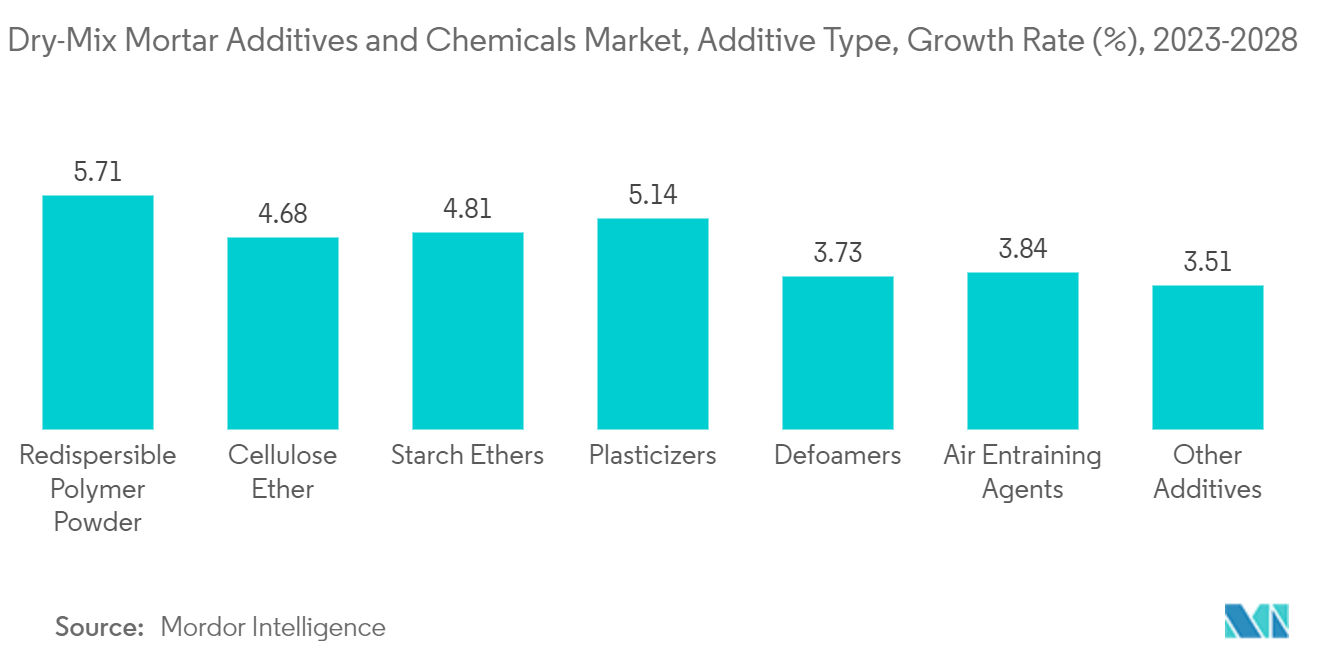Market Trends of Dry-mix Mortar Additives And Chemicals Industry
Re-dispersible Polymer Powder Likely to Dominate the Additives Segment
- Re-dispersible powders are obtained by spray drying the corresponding aqueous polymer dispersions containing a redispersing agent while adding finely ground inorganic materials as anticaking agents. The re-dispersibility of the polymer powder is the most critical parameter to achieving mortar performances, like adhesion onto the substrate and abrasion resistance.
- Re-dispersible polymer powder is the most important binder in cement- and gypsum-based dry powder material. Re-dispersible polymer powder is a spray-dried powder of polymer emulsion. It is re-emulsified with water and has the same properties as the original emulsion, i.e., a film can be formed after water evaporation. This film has high toughness, weather resistance, and adhesion to a substrate. In addition, the latex powder with hydrophobic properties can improve the waterproof performance of the waterproof mortar.
- Performance of re-dispersible polymer powder in a dry mortar:
- Improves the adhesion of dry mortar to various substrates and ensures the weather resistance of mortar bond strength under different conditions of use. For example, it may be used to improve the bond strength between mortar and EPS board, EPS particles, concrete walls, and brick walls in the thermal mortar.
- Re-dispersible polymer powder can reduce the water absorption of the material, and the special hydrophobic latex powder effect is more pronounced. It reduces water and damage caused by water to the molded mortar.
- Some re-dispersible polymer powders can improve sag resistance and fluidity of the mortar to improve the construction performance of the mortar.
- Thus, the demand for the re-dispersible polymer powder segment is likely to increase in the market studied.

Asia-Pacific to Dominate the Market
- Asia-Pacific is expected to account for the largest share of the overall dry-mix mortar additives and chemicals market during the forecast period.
- Currently, China, India, and ASEAN Countries are among the largest producer and consumers of dry mix mortar in the region and the fastest-growing countries in terms of consumption of dry mix mortar.
- China holds the largest Asia-Pacific market share for the dry-mix mortar additives and chemicals market.
- In 2021, Sika AG opened a new production facility of mortar in Jiaxing City, in the province of Zhejiang in Eastern China, in response to high demand from the region.
- In 2022, Sika AG opened a new plant for liquid membranes and mortar production in Chongqing, a city in southwestern China. The automotive, finance, and logistics sectors are well represented in the Chengdu-Chongqingregion and the construction industry benefits from these operations and companies' efforts to achieve more sustainable production.
- The demand for the dry-mix mortar additives and chemicals market is expected to rise throughout the forecast period due to rising investments and construction activity in the country. China is a huge contributor, as it has been one of the leading investors in infrastructure worldwide over the past few years. For instance, according to the National Bureau of Statistics (NBS) of China, in 2022, the output value of construction works in China amounted to CNY 27.63 trillion (USD 4,108.581 billion), an increase of 6.6% compared with 2021.
- Moreover, according to the country's Ministry of Housing and Urban-Rural Development, the construction industry will maintain a 6% share of the country's GDP by 2025. There is a growing trend in the country for prefabricated buildings, which is expected to account for more than 30% of the country's new construction.
- According to the National Development and Reform Commission, the Chinese government approved 26 infrastructure projects at an estimated investment of about USD 142 billion, which are estimated to be completed by 2023. The growing demand for housing is expected to drive residential construction in the public and private sectors.
- Furthermore, India is also witnessing considerable investments in infrastructure projects, likely to provide massive demand for the market studied. Thus, growing infrastructural development in India is expected to augment the demand for dry-mix mortar additives and chemicals.
- According to IBEF, in Union Budget 2022-2023, the government allocated INR 10,00,000 crore (USD 130.57 billion) to enhance the infrastructure sector. Moreover, India plans to spend USD 1.4 trillion on infrastructure through the 'National Infrastructure Pipeline' in the next five years.
- According to the Desalination Association of India, there are more than 1000 desalination plants of various capacities ranging from 20 m3/day to 10,000 m3 /day. Most of the large desalination plants in India are in the municipal sector. NITI Aayog (Government Central Planning Commission) plans to set up more plants in water scare cities like Chennai, Mumbai, Kolkata, Surat, and Vizag. This is expected to drive the market of polymer-modified dry-mix mortar waterproofing slurries. Waterproofing slurries are used in pipes and tanks, which might be prone to weathering, stress, and crack formation. Thus, this is expected to bolster India's demand for dry-mix mortar additives and chemicals.
- Hence, owing to the aforementioned factors, the demand for dry-mix mortar additives and chemicals is expected to increase in Asia-Pacific over the forecast period rapidly.

